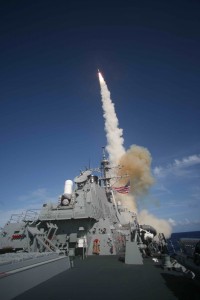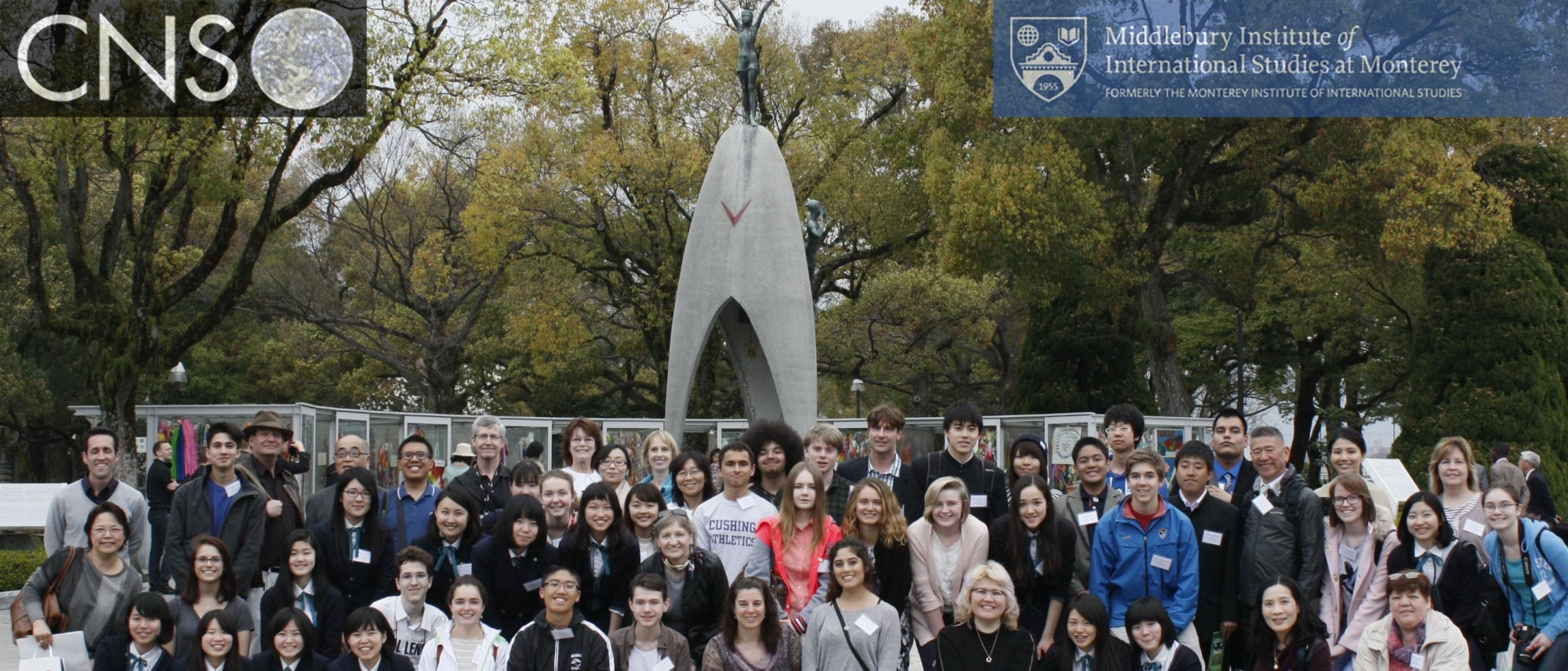Toward a World without Nuclear Weapons:
Progress, Prospects, and Challenges
At this critical time in our nuclear history, it is very important for leaders of the next generation to take action to reduce the threat of nuclear weapons. The Critical Issues Forum (CIF) therefore will focus its 2012-2013 program on the twofold question of the feasibility and desirability of a world free of nuclear weapons. We will explore progress made and challenges that still remain. Participants will examine this topic in CIF’s four content domains: scientific/environmental, social/cultural, economic, and political /geopolitical.
 Introduction
Introduction
The idea of nuclear disarmament looked promising when President Obama made his now-famous Prague speech in April 2009, pledging to put an end to Cold War thinking by reducing the role of nuclear weapons in U.S. national security strategy. Early in his first term, President Obama stated his personal commitment to seek peace and security through a world without nuclear weapons. His speech was the first declared commitment of a sitting president to work towards nuclear disarmament since President Truman.
The new momentum toward a nuclear-free world began on January 4, 2007, with an op-ed in the Wall Street Journal by four former major U.S. national security leaders – Henry Kissinger, Sam Nunn, William Perry, and George Shultz – urging public debate within the U.S. and elsewhere to develop a vision and practical steps toward creating a world free of nuclear weapons. More op-eds by these four statesmen followed, creating an initiative for nuclear disarmament at a very critical time, when the international community was facing new and ongoing nuclear threats – Iran and North Korea – with no new significant arms control reductions between the United States and Russia. Moreover, other nuclear weapon states were not and still are not part of the nuclear arms reduction process.
In reality, achievements toward nuclear disarmament during Obama’s first term were, at best, very modest. They included the conclusion of the New START Treaty between the U.S. and Russia and a reasonably successful 2010 NPT Review Conference, whose final document contains an action plan for nuclear nonproliferation and disarmament. The Nuclear Posture Review issued in April 2010 also states the need to reduce the roles of nuclear weapons in global affairs.
Gauging progress towards nuclear disarmament is complicated by shifts in the numbers of weapons and in policies governing these weapons. In terms of quantitative reductions, measurable steps have been taken by key nuclear weapon states (NWS) both unilaterally and bilaterally. The NWS collectively reduced the size of their nuclear arsenals from over 70,000 warheads at the height of the Cold War to fewer than 19,000 by 2012. These reductions have been carried out unilaterally by at least four NWS, as well as through bilateral legally binding arrangements between the United States and the Soviet Union/Russian Federation.
However, major challenges to the vision of a world without nuclear weapons remain. First and foremost, it is difficult to perceive, more than sixty years after their invention, how nuclear weapons will cease from being the basis for a number of states’ national security policies and for global stability in general.
Source: Ploughshares Fund
Two decades after the Cold War, the approximately 19,000 existing nuclear warheads remain in the arsenals of eight states (China, France, Israel, India, Pakistan, the Russian Federation, the United Kingdom, and the United States). Some 4,400 are actively deployed. A large amount of fissile material, including weapons-useable highly enriched uranium and separated plutonium, still exists in the world today.
Ongoing tension between nuclear “haves” and “have-nots”—states with and without nuclear arsenals—persists over their Nuclear Nonproliferation Treaty (NPT) obligations and continues to stall the disarmament process.
Furthermore, attempts to negotiate legally binding multilateral nuclear disarmament treaties have proved challenging. Fifteen years after it opened for signature, the Comprehensive Nuclear-Test-Ban Treaty (CTBT) banning nuclear explosions has yet to enter into force. Since the U.S. Senate rejected CTBT ratification in 1999, the entry into force of the treaty remains improbable. Furthermore, the Conference on Disarmament (CD) has been locked in perpetual stalemate over Fissile Material Cut-Off Treaty (FMCT) negotiations since 1996. Negotiations on an FMCT have not commenced even 17 years after agreement on the Shannon Mandate (a mandate adopted by the CD in 1995 that proposed the negotiation of a treaty banning the production of fissile material).

Aegis Ballistic Missile Defense (mda.mil)
Russia and China consider U.S. missile defense to be a factor that could destabilize strategic stability – China is believed to be modernizing nuclear weapons and their delivery systems. The threat of terrorist groups acquiring nuclear and radiological materials is still real.
For these reasons, many people are cynical about the vision of a world without nuclear weapons. They believe that this vision is ultimately unfeasible.
However, certain national governments and members of civil society have cooperated on initiatives to promote progress towards a nuclear-free world. For example, the New Agenda Coalition (NAC) was formed in June 1998 when foreign ministers from Brazil, Egypt, Ireland, Mexico, New Zealand, Slovenia (which later withdrew from the NAC), South Africa, and Sweden issued a statement calling for a new nuclear disarmament agenda, “Toward a Nuclear-Weapons-Free World: Time for a New Agenda.”
The NAC played an instrumental role in convincing the NWS to agree to the thirteen practical steps towards nuclear disarmament in the final document of the 2000 NPT Review Conference.
Following President Obama’s Prague speech, some national governments have cooperated on initiatives to promote progress towards a world free of nuclear weapons. Other countries have voiced some support for disarmament efforts, including the United Kingdom, Australia and Japan.
In 2008, Japan and Australia established the International Commission on Nuclear Non-Proliferation and Disarmament (ICNND), an independent commission to reinvigorate international nonproliferation and disarmament efforts, and to help shape consensus at the then-upcoming 2010 NPT Review Conference. Japan and Australia joined together again in September 2010 to create the Nonproliferation and Disarmament Initiative (NPDI). The group consists of ten countries (Australia, Canada, Chile, Germany, Japan, Mexico, the Netherlands, Poland, Turkey and the United Arab Emirates) who aim to facilitate the implementation of measures from the consensus document of the 2010 NPT Review Conference. NPDI strives to support efforts to negotiate the FMCT, increase nuclear safety and safeguards, and encourage entry into force of the CTBT.
Furthermore, since the 2010 NPT Review Conference, the idea of a nuclear weapons convention that outlaws nuclear weapons has gained momentum, with the final document for the NPT Review Conference making reference to such a convention.
 Source: Center for Nonproliferation Studies
Source: Center for Nonproliferation Studies
People often argue that nuclear weapons cannot be dis-invented. However, two other categories of weapons of mass destruction – chemical and biological weapons – as well as landmines and cluster munitions have been deemed illegal and outlawed. Therefore, the idea of de-legitimizing the most destructive weapons in the world, nuclear weapons, is increasingly receiving support in recent years.
This year’s CIF project will take a close look at the vision of world without nuclear weapons, both the challenges and prospects. We will examine three topics in a three-step process:
- Fact finding, state motivations and deterrence
Students will take stock of the current status of nuclear weapons worldwide, including the number of nuclear weapons (both deployed and non-deployed) in both NPT nuclear weapon states and non-NPT nuclear weapon states. They will study factual information such as the scientific aspects of nuclear weapons, including basic weapon types and design, and the effects of nuclear weapon use. Students will also examine the role of nuclear weapons during and after the Cold War and investigate why countries attempt to acquire nuclear weapons, the concept of deterrence, and various current and past efforts to reduce the threat of nuclear weapons, including multilateral, bilateral and unilateral initiatives.
- Identifying progress toward nuclear disarmament, as well as the remaining political and technical challenges
Students will investigate progress toward nuclear disarmament before and after the Cold War. Progress includes the reduction in the number of nuclear weapons from the height of the Cold War through the US-Russian bilateral arms control treaties, unilateral initiatives by some other nuclear weapon states, and disarmament initiatives by other countries as well as civil society. While the prospect of nuclear disarmament was bright when Obama made his Prague speech promising a world free of nuclear weapons, numerous challenges to progress on nuclear disarmament remain. The divisions between nuclear haves and have-nots with regard to treaty obligations are on full display. New proliferation threats have emerged, including enrichment and weapons development activities in Iran and North Korea, respectively; the possible acquisition of nuclear material or weapons by terrorist groups; and the potential modernization of arsenals in official nuclear weapons states.
3. Future Prospects: What should be done to free the world of nuclear weapons?
Students will explore the security benefits and possible risks of reducing or eliminating nuclear arsenals. What are the political and technical obstacles to achieving the goal of a world free of nuclear weapons? Despite numerous challenges on the path toward a world free of nuclear weapons, many national governments and members of civil society have cooperated in initiatives to promote progress toward this goal. CIF high school students, the next generation of leaders of nuclear disarmament, need to develop their own vision for a safer future world.
PDF version of the ‘12-’13 Teachers Workshop Concept Paper



